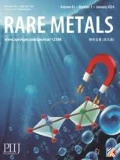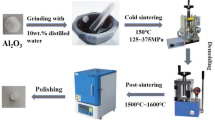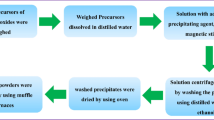Abstract
A series of Y2O3 fully stabilized HfO2 ceramics (Hf1−xYxO2−0.5x, x = 0.20, 0.24, 0.28, 0.32, 0.36 and 0.40) were synthesized by solid-state reaction at 1500 °C. The phase composition, thermal conductivity and sintering behavior at 1400 °C of the ceramic bulks were studied. The Hf1−xYxO2−0.5x ceramics were comprised of pure cubic phase with disordered fluorite structure. No phase transformation occurred in the ceramics with Y3+ doping concentration ranging from 0.24 to 0.36. Both Hf0.64Y0.36O1.82 and Hf0.6Y0.4O1.8 samples revealed the lowest grain growth rate when sintered at 1400 °C, indicating good resistance to sintering. However, the Vicker’s hardness and Young’s modulus after annealed for 96 h at 1400 °C for the Hf0.64Y0.36O1.82 sample were 8.97 and 200 GPa, respectively, much lower than those of the Hf0.6Y0.4O1.8 (14.51 and 237 GPa, respectively). The thermal conductivity of Hf1−xYxO2−0.5x first decreased and then increased slowly as the Y3+ content increased, and the associated mechanism was discussed.













Similar content being viewed by others
References
Miller RA. Thermal barrier coatings for aircraft engines: history and directions. J Therm Spray Technol. 1997;6(1):35.
Feng B, Wang Y, Jia Q, Huang W, Suo H, Ma W. Thermophysical properties of solution precursor plasma-sprayed La2Ce2O7 thermal barrier coatings. Rare Met. 2019;38(7):689.
Padture NP, Gell M, Jordan EH. Thermal barrier coatings for gas-turbine engine applications. Science. 2002;296(5566):280.
Liu M, Zhang G, Lu Y, Han J, Li G, Li C, Li C, Yang G. Plasma spray–physical vapor deposition toward advanced thermal barrier coatings: a review. Rare Met. 2019. https://doi.org/10.1007/s12598-019-01351-x.
Miller RA, Lowell CE. Failure mechanisms of thermal barrier coatings exposed to elevated temperatures. Thin Solid Films. 1982;95(3):265.
Schlichting KW, Padture NP, Jordan EH, Gell M. Failure modes in plasma-sprayed thermal barrier coatings. Mater Sci Eng A. 2003;342(1–2):120.
Trice RW, Su YJ, Mawdsley JR, Faber KT, Arellano-López ARD, Wang H, Porter WD. Effect of heat treatment on phase stability, microstructure, and thermal conductivity of plasma-sprayed YSZ. J Mater Sci. 2002;37(11):2359.
Wang J, Li H, Stevens R. Hafnia and hafnia-toughened ceramics. J Mater Sci. 1992;27(20):5397.
Tang J, Zhang F, Zoogman P, Fabbri J, Chan SW, Zhu Y, Brus LE, Steigerwald ML. Martensitic phase transformation of isolated HfO2, ZrO2, and HfxZr1−xO2 (0<x<1) nanocrystals. Adv Funct Mater. 2010;15(10):1595.
Andrievskaya ER. Phase transformations in the ternary systems ZrO2 (HfO2)–Y2O3–Eu2O3 at 1250 °C. In: 7th Conference of the European-Ceramic-Society Brugge. Belgium: Key Eng Mater Trans Tech Publ. 2002;206:719.
Matsumoto K, Itoh Y, Kameda T. EB-PVD process and thermal properties of hafnia-based thermal barrier coating. Sci Technol Adv Mater. 2003;4(2):153.
Dongming Zhu RAM. Sintering and creep behavior of plasma-sprayed zirconia- and hafnia-based thermal barrier coatings. Surf Coat Technol. 1998;108(1–3):114.
Zhu D, Miller RA. Hafnia-based materials developed for advanced thermal/environmental barrier coating applications. 2004. https://ntrs.nasa.gov/search.jsp?R=20050192261.
Li C, Ma Y, Xue Z, Yang Y, Chen J, Guo H. Effect of Y doping on microstructure and thermophysical properties of yttria stabilized hafnia ceramics. Ceram Int. 2018;44(15):18213.
Dole SL, Hunter OJ, Wooge CJ. Elastic properties of monoclinic hafnium oxide at room temperature. J Am Ceram Soc. 1977;60(11–12):488.
Ibegazene H, Alperine S, Diot C. Yttria-stabilized hafnia-zirconia thermal barrier coat. J Mater Sci. 1995;30(4):938.
Wang Y, Duncan K, Wachsman ED, Ebrahimi F. The effect of oxygen vacancy concentration on the elastic modulus of fluorite-structured oxides. Solid State Ion. 2007;178(1–2):53.
Chen PL, Chen IW. Grain growth in CeO2: dopant effects, defect mechanism, and solute drag. J Am Ceram Soc. 2010;79(7):1793.
Wang CC, Lei CM, Wang GJ, Sun XH, Li T, Huang SG, Wang H, Li YD. Oxygen-vacancy-related dielectric relaxations in SrTiO3 at high temperatures. J Appl Phys. 2013;113(9):392.
Vigreux C, Deneuve B, Fallah JE, Haussonne JM. Effects of acceptor and donor additives on the properties of MgTiO3 ceramics sintered under reducing atmosphere. J Eur Ceram Soc. 2001;21(10):1681.
Guo X, Waser R. Electrical properties of the grain boundaries of oxygen ion conductors: acceptor-doped zirconia and ceria. Prog Mater Sci. 2006;51(2):151.
Khan MS, Islam MS, Bates DR. Cation doping and oxygen diffusion in zirconia: a combined atomistic simulation and molecular dynamics study. J Mater Chem. 1998;8(10):2299.
Zacate MO, Minervini L, Bradfield DJ, Grimes RW, Sickafus KE. Defect cluster formation in M2O3-doped cubic ZrO2. Solid State Ion. 2000;128(1):243.
Subramanian R. Highly defective oxides as sinter resistant thermal barrier coating. U.S. Patent 6,930,066. 2005.
Siebert B, Funke C, Vaβen R, Stöver D. Changes in porosity and Young’s modulus due to sintering of plasma sprayed thermal barrier coatings. J Mater Process Technol. 1999;92:217.
Zhang QC, Ma D. Acoustic measurement of elastic constant for ceramic materials. J Inorg Mater. 1989;4(4):010.
Ye DL, Hu JH. Manual of practical inorganic matter thermodynamics. Beijing: Metallurgical Industry Press; 2002. 443.
Asmani M, Kermel C, Leriche A, Ourak M. Influence of porosity on Young's modulus and Poisson's ratio in alumina ceramics. J Eur Ceram Soc. 2001;21(8):1081.
Subramanian MA, Aravamudan G, Rao GVS. Oxide pyrochlores—a review. Prog Solid State Chem. 1983;15(2):55.
Scheetz BE, White WB. ChemInform abstract: characterization of anion disorder in zirconate A2B2O7 compounds by Raman spectroscopy. J Am Ceram Soc. 1980;11(4):468.
Goff JP, Hayes W, Hull S, Hutchings MT, Clausen KN. Defect structure of yttria-stabilized zirconia and its influence on the ionic conductivity at elevated temperatures. Phys Rev B Condens Matter. 1999;59(22):14202.
Spiridonov FN, Komissarova LN, Kogarov LG, Spitsin VN. System HfO2–Y2O3. Zh Neorg Khim. 1969;14(9):2535.
Schulz U, Saruhan B, Fritscher K, Leyens C. Review on advanced EB-PVD ceramic topcoats for tbc applications. Int J Appl Ceram Technol. 2010;1(4):302.
Li W, Zhao H, Zhong X, Wang L, Tao S. Air plasma-sprayed yttria and yttria-stabilized zirconia thermal barrier coatings subjected to calcium-magnesium-alumino-silicate (CMAS). J Therm Spray Technol. 2014;23(6):975.
Acknowledgements
This research was financially sponsored by the National Natural Science Foundation of China (Nos. U1537212 and 51471019), China Postdoctoral Science Foundation (Nos. 2017T100023 and 2016M600028) and the National Key Research and Development Program of China (No. 2016YFB0300901).
Author information
Authors and Affiliations
Corresponding author
Rights and permissions
About this article
Cite this article
Li, C., He, J. & Ma, Y. Sintering behavior and thermal conductivity of Y2O3 fully stabilized HfO2 ceramics. Rare Met. 40, 1255–1266 (2021). https://doi.org/10.1007/s12598-020-01421-5
Received:
Revised:
Accepted:
Published:
Issue Date:
DOI: https://doi.org/10.1007/s12598-020-01421-5




